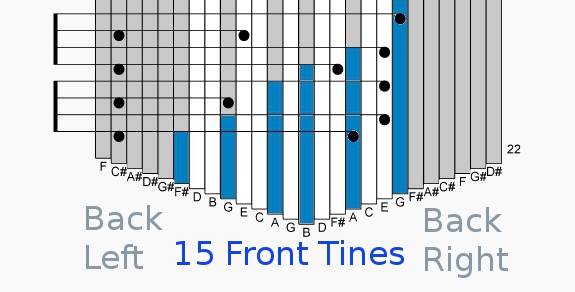It’s time to celebrate! On July 4 we Americans celebrate Independence Day. (Although I would actually rather be celebrating Interdependence Day – because the one truth that I have learned about the world economy is that we are all in this together.) I celebrate in this article with a short video of the patriotic American song “Stars and Stripes Forever” played on the Alto Chromatic Kalimba.
And there is another reason to celebrate: the Box Alto Chromatic Kalimba will be back in stock by July 12, 2019, available for shipment by July 15!
The Alto Chromatic kalimba’s front side looks and sounds exactly like the Alto kalimba. That means that if you have ever played the Alto kalimba, or if you have ever played one of the newer 17-note Chinese kalimbas, everything you learned on one of those kalimbas can be immediately played on the front side of this kalimba.

The regular old diatonic kalimba is really a great instrument – mainly because, without the flats or sharps, or the notes that are out of the key, the diatonic kalimba is a fun and fairly easy instrument to play. There are thousands of songs you can play on the diatonic kalimba, so you have a lot of musical freedom with a reasonably low investment in learning the instrument.
That said, you can only go so far dodging the required, but missing, chromatic notes (the chromatic scale includes the diatonic notes plus all the flats or sharps in between.) If you are ready for the full chromatic kalimba experience, it might be time for you to get one of the Hugh Tracey Chromatic Kalimbas.
The Hugh Tracey Chromatic Alto kalimba has a very interesting design, with the “flats” on the back. Each tine with a dot on its playing tip has its “flat” right behind it. In order to play the flats, you use your finger nails, on the back side. Think about a “squeezebox” when you play, squeezing (plucking) the front with the thumb and the back with your fingers. I use my middle fingers on the back, though some players use three or even four fingers on the back side.
Admittedly, not being able to see the back side tines is a distinct disadvantage when learning this instrument. You do need to be able to play “by feel,” which is difficult and takes time. And I can give you four useful tips to assist you in learning to play the back side notes:
The chromatic kalimba is a complicated instrument that defaults to something simple on the front side, but when you integrate the chromatic notes on the back you will possess an instrument that can challenge and gratify you for the rest of your life as you become adept at playing (at first) partially and then fully chromatic music.


Sign up for our newsletter and free resources with your email address:
We pinky promise not to spam you and to only send good stuff.
 Christmas in July 2025
Christmas in July 2025 Patriotic and American Music for Kalimba
Patriotic and American Music for Kalimba